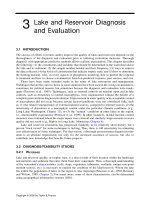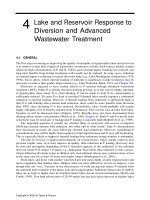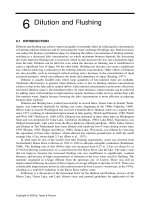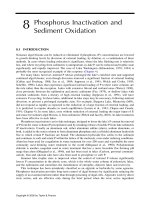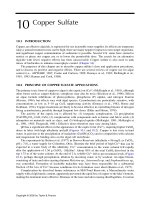Operation management 4th reil sanders wiley chapter 8
Bạn đang xem bản rút gọn của tài liệu. Xem và tải ngay bản đầy đủ của tài liệu tại đây (1.06 MB, 31 trang )
Chapter 8 - Forecasting
Operations Management
by
R. Dan Reid & Nada R. Sanders
3rd Edition © Wiley 2007
PowerPoint Presentation by R.B. Clough – UNH
M. E. Henrie - UAA
© Wiley 2007
Principles of Forecasting
Many types of forecasting models
Each differ in complexity and amount of data
Forecasts are perfect only by accident
Forecasts are more accurate for grouped data than for
individual items
Forecast are more accurate for shorter than longer time
periods
© Wiley 2007
Forecasting Steps
Decide what needs to be forecast
Evaluate and analyze appropriate
data
Identify needed data & whether it’s available
Select and test the forecasting model
Level of detail, units of analysis & time horizon
required
Cost, ease of use & accuracy
Generate the forecast
Monitor forecast accuracy over time
© Wiley 2007
Types of Forecasting
Models
Qualitative methods – judgmental
methods
Forecasts generated subjectively by the
forecaster
Educated guesses
Quantitative methods:
Forecasts generated through mathematical
modeling
© Wiley 2007
Qualitative Methods
© Wiley 2007
Quantitative Methods
Time Series Models:
Assumes information needed to generate a
forecast is contained in a time series of data
Assumes the future will follow same patterns
as the past
Causal Models or Associative Models
Explores cause-and-effect relationships
Uses leading indicators to predict the future
E.g. housing starts and appliance sales
© Wiley 2007
Causal Models
Causal models establish a cause-and-effect
relationship between dependent variable to
be forecast (Y) and independent variables
(xi)
A common tool of causal modeling is
multiple linear regression:
Y = a + b1x1 + b 2 x 2 + + b k x k
Often, leading indicators can be included to
help predict changes in future demand e.g.
housing starts
© Wiley 2007
Time Series Models
Forecaster looks for data patterns as
Data = historic pattern + random variation
Historic pattern to be forecasted:
Level (long-term average) – data fluctuates around a
constant mean
Trend – data exhibits an increasing or decreasing
pattern
Seasonality – any pattern that regularly repeats itself
and is of a constant length
Cycle – patterns created by economic fluctuations
Wiley 2007
Random Variation ©
cannot
be predicted
Time Series Patterns
© Wiley 2007
Time Series Models
Naive:
The forecast is equal to the actual value observed
during the last period – good for level patterns
Simple Mean: F
t +1
Ft +1 = At
= ∑ At / n
The average of all available data - good for level
patterns
F = ∑A
Moving Average:
t +1
t
/n
The average value over a set time period
(e.g.: the last four weeks)
Each new forecast drops the oldest data point &
adds a new observation
More responsive to a trend but still lags behind
actual data
© Wiley 2007
Time Series Problem
Solution
Period
Actual
2-Period
4-Period
1
300
2
315
3
290
4
345
5
320
6
360
7
375
340.0
328.8
8
367.5
350.0
© Wiley 2007
Time Series Models
(continued)
Ft +1 = ∑ C t A t
Weighted Moving Average:
All weights must add to 100% or 1.00
e.g. Ct .5, Ct-1 .3, Ct-2 .2 (weights add to 1.0)
Allows emphasizing one period over others; above
indicates more weight on recent data (C t=.5)
Differs from the simple moving average that
weighs all periods equally - more responsive to
trends
© Wiley 2007
Time Series Models
(continued)
(
)
Exponential Smoothing:
Ft +1 = αA t + 1 − α Ft
Most frequently used time series method
because of ease of use and minimal amount of
data needed
α
Need just three pieces of data to start:
Last period’s forecast (Ft)
Last periods actual value (At)
Select value of smoothing coefficient, α
,between 0 and 1.0
If no last period forecast is available, average
the last few periods or use naive method
Higher values (e.g. .7 or .8) may place too
much weight on last period’s random variation
α
© Wiley 2007
Time Series Problem
Solution
Period
Actual
2-Period
4-Period
2-Per.Wgted.
Expon. Smooth.
1
300
2
315
3
290
4
345
5
320
6
360
7
375
340.0
328.8
344.0
372.0
8
367.5
350.0
369.0
372.6
© Wiley 2007
Time Series Problem
Period Actual
Determine forecast for
periods 7 & 8
2-period moving average
4-period moving average
2-period weighted moving
average with t-1 weighted
0.6 and t-2 weighted 0.4
Exponential smoothing
with alpha=0.2 and the
period 6 forecast being 375
1
300
2
315
3
290
4
345
5
320
6
360
7
375
8
© Wiley 2007
Forecasting Trends
Basic forecasting models for trends compensate
for the lagging that would otherwise occur
One model, trend-adjusted exponential
smoothing uses a three step process
Step 1 - Smoothing the level of the series
S t = αA t + (1 − α)(S t −1 + Tt −1 )
Step 2 – Smoothing the trend
Tt = β(S t − S t −1 ) + (1 − β)Tt −1
Forecast including the trend
FITt +1 = S t + Tt
© Wiley 2007
Forecasting trend problem: a company uses exponential smoothing with
trend to forecast usage of its lawn care products. At the end of July the
company wishes to forecast sales for August. July demand was 62. The
trend through June has been 15 additional gallons of product sold per
month. Average sales have been 57 gallons per month. The company uses
alpha+0.2 and beta +0.10. Forecast for August.
Smooth the level of the series:
S July = αA t + (1 − α)(S t −1 + Tt −1 ) = ( 0.2)( 62) + ( 0.8 )( 57 + 15 ) = 70
Smooth the trend:
Forecast including trend:
TJuly = β(St − St −1 ) + (1 − β)Tt −1 = ( 0.1)( 70 − 57 ) + ( 0.9 )(15) = 14.8
FITAugust = S t + Tt = 70 + 14.8 = 84.8 gallons
© Wiley 2007
Linear Regression
b=
∑ XY − (( X )∑ Y )
∑ X 2 − ( ( X )∑ X )
Identify dependent (y)
and independent (x)
variables
Solve for the slope of
the line XY − n X Y
b=
∑
∑X
2
− nX
2
Solve for the y intercept
Develop your equation
for the trend line
a = Y − bX
Y=a + bX
© Wiley 2007
Linear Regression Problem: A maker of golf shirts has
been tracking the relationship between sales and
advertising dollars. Use linear regression to find out what
sales might be if the company invested $53,000 in
advertising next year.
Sales $ Adv.$
(Y)
(X)
1
130
32
XY
4160
XY − n XY
∑
b=
∑ X − nX
X^
2
Y^2
230
4
16,90
0
b=
2
2
28202 − 4( 47.25 )( 147.25 )
9253 − 4( 47.25 )
2
= 1.15
2
151
52
7852
270
4
22,80
1
a = Y − b X = 147.25 − 1.15( 47.25 )
3
150
50
7500
250
0
22,50
0
Y = a + bX = 92.9 + 1.15X
4
158
55
8690
302 24964
5
5
153.8
5
53
Tot
589
189
2820
© Wiley 2007
925 87165
a = 92.9
Y = 92.9 + 1.15( 53 ) = 153.85
How Good is the Fit? –
Correlation Coefficient
Correlation coefficient (r) measures the direction and strength of
the linear relationship between two variables. The closer the r
value is to 1.0 the better the regression line fits the data points.
n( ∑ XY ) − ( ∑ X )( ∑ Y )
r=
n
r=
(∑ X ) − ( ∑ X)
2
2
* n
(∑ Y ) − ( Y)
2
2
4( 28,202 ) − 189( 589 )
4(9253) - (189) * 4( 87,165 ) − ( 589 )
2
r 2 = ( .982 ) = .964
2
= .982
2
Coefficient of determination
( ) measures the amount of
2
r variable about its mean that is
variation in the dependent
explained 2by the regression line. Values of ( ) close to 1.0 are
desirable.r
© Wiley 2007
Measuring Forecast Error
Forecasts are never perfect
Need to know how much we
should rely on our chosen
forecasting method
Measuring forecast error:
E t = A t − Ft
Note that over-forecasts =
negative errors and underforecasts = positive errors
© Wiley 2007
Measuring Forecasting Accuracy
actual − forecast
∑
MAD =
Mean Absolute Deviation
(MAD)
n
measures the total error in a
forecast without regard to sign
Cumulative Forecast Error
(CFE)
CFE = ∑ ( actual − forecast )
Measures any bias in the forecast
MSE =
Mean Square Error (MSE)
2
(
)
actual
forecast
∑
Penalizes larger errors
TS =
Tracking Signal
Measures if your model is working
© Wiley 2007
n
CFE
MAD
Accuracy & Tracking Signal Problem: A company is
comparing the accuracy of two forecasting methods. Forecasts
using both methods are shown below along with the actual values
for January through May. The company also uses a tracking signal
with ±4 limits to decide when a forecast should be reviewed.
Which forecasting method is best?
Method A
Method B
Month
Actu
al
sales
F’cas
t
Error
Cum.
Error
Trackin
g
Signal
F’cas
t
Error
Cum.
Error
Tracking
Signal
Jan.
30
28
2
2
2
27
2
2
1
Feb.
26
25
1
3
3
25
1
3
1.5
Marc
h
32
32
0
3
3
29
3
6
3
April
29
30
-1
2
2
27
2
8
4
May
31
30
1
3
3
29
2
10
5
MAD
1
MSE
1.4
2
© Wiley 2007
4.4
Selecting the Right Forecasting
Model
The amount & type of available data
Degree of accuracy required
Increasing accuracy means more data
Length of forecast horizon
Some methods require more data than others
Different models for 3 month vs. 10 years
Presence of data patterns
Lagging will occur when a forecasting model
meant for a level pattern is applied with a trend
© Wiley 2007
Forecasting Software
Spreadsheets
Statistical packages
Microsoft Excel, Quattro Pro, Lotus 1-2-3
Limited statistical analysis of forecast data
SPSS, SAS, NCSS, Minitab
Forecasting plus statistical and graphics
Specialty forecasting packages
Forecast Master, Forecast Pro, Autobox, SCA
© Wiley 2007


